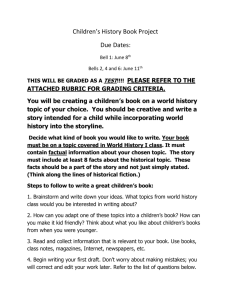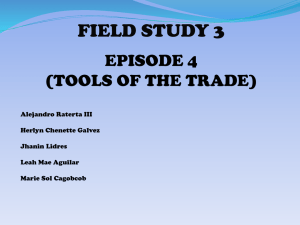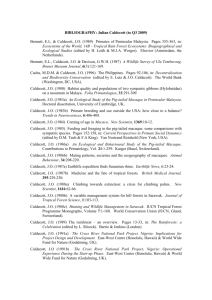Classroom Connections- Caldecott Black and White 11
advertisement
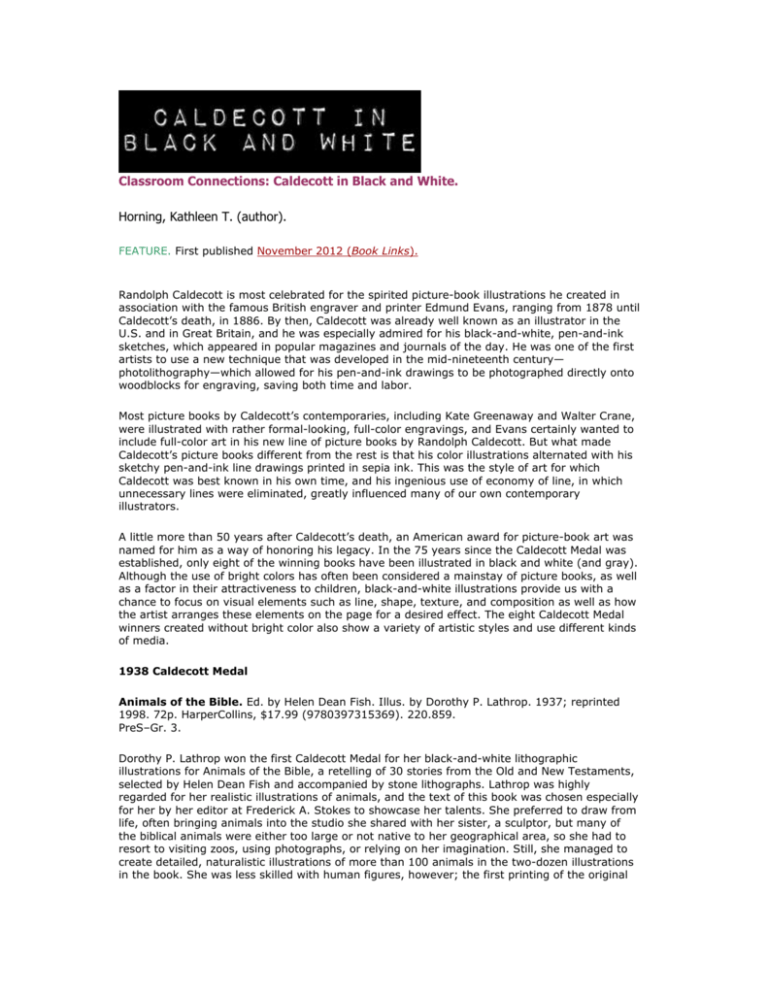
Classroom Connections: Caldecott in Black and White. Horning, Kathleen T. (author). FEATURE. First published November 2012 (Book Links). Randolph Caldecott is most celebrated for the spirited picture-book illustrations he created in association with the famous British engraver and printer Edmund Evans, ranging from 1878 until Caldecott’s death, in 1886. By then, Caldecott was already well known as an illustrator in the U.S. and in Great Britain, and he was especially admired for his black-and-white, pen-and-ink sketches, which appeared in popular magazines and journals of the day. He was one of the first artists to use a new technique that was developed in the mid-nineteenth century— photolithography—which allowed for his pen-and-ink drawings to be photographed directly onto woodblocks for engraving, saving both time and labor. Most picture books by Caldecott’s contemporaries, including Kate Greenaway and Walter Crane, were illustrated with rather formal-looking, full-color engravings, and Evans certainly wanted to include full-color art in his new line of picture books by Randolph Caldecott. But what made Caldecott’s picture books different from the rest is that his color illustrations alternated with his sketchy pen-and-ink line drawings printed in sepia ink. This was the style of art for which Caldecott was best known in his own time, and his ingenious use of economy of line, in which unnecessary lines were eliminated, greatly influenced many of our own contemporary illustrators. A little more than 50 years after Caldecott’s death, an American award for picture-book art was named for him as a way of honoring his legacy. In the 75 years since the Caldecott Medal was established, only eight of the winning books have been illustrated in black and white (and gray). Although the use of bright colors has often been considered a mainstay of picture books, as well as a factor in their attractiveness to children, black-and-white illustrations provide us with a chance to focus on visual elements such as line, shape, texture, and composition as well as how the artist arranges these elements on the page for a desired effect. The eight Caldecott Medal winners created without bright color also show a variety of artistic styles and use different kinds of media. 1938 Caldecott Medal Animals of the Bible. Ed. by Helen Dean Fish. Illus. by Dorothy P. Lathrop. 1937; reprinted 1998. 72p. HarperCollins, $17.99 (9780397315369). 220.859. PreS–Gr. 3. Dorothy P. Lathrop won the first Caldecott Medal for her black-and-white lithographic illustrations for Animals of the Bible, a retelling of 30 stories from the Old and New Testaments, selected by Helen Dean Fish and accompanied by stone lithographs. Lathrop was highly regarded for her realistic illustrations of animals, and the text of this book was chosen especially for her by her editor at Frederick A. Stokes to showcase her talents. She preferred to draw from life, often bringing animals into the studio she shared with her sister, a sculptor, but many of the biblical animals were either too large or not native to her geographical area, so she had to resort to visiting zoos, using photographs, or relying on her imagination. Still, she managed to create detailed, naturalistic illustrations of more than 100 animals in the two-dozen illustrations in the book. She was less skilled with human figures, however; the first printing of the original book shows a child with two left feet in her illustration of “The Peaceable Kingdom.” In the Classroom Consider any or all of the eight Caldecott Medal books illustrated in black and white and discuss the artwork’s effectiveness in helping to tell a story. Would the story have seemed different if it had been illustrated in color? Common Core Connection: RL.3.7. Explain how specific aspects of a text’s illustrations contribute to what is conveyed by the words in a story (e.g., create mood, emphasize aspects of a character or setting). 1939 Caldecott Medal Mei Li. By Thomas Handforth. Illus. by the author. 1938; reprinted 1990. 48p. Doubleday, o.p. K–Gr. 2. This award winner follows a lively young girl who is living in what was then contemporary Peking and runs away to see the New Year’s Fair. Thomas Handforth was an American artist who spent most of his career traveling around the world, drawing and painting what he saw. He spent six years in Beijing, China, in the 1930s, and while he was there, he taught himself stone lithography. He felt that he was better able to capture the spirit of China through lithographs, and he created the illustrations for Mei Li with brush and lithograph pencil reproduced on copper plates. Using broad, sweeping strokes, he wanted his art to echo a Chinese painting technique used by poets in calligraphy called hsieh-yi, which translates as “to write with meaning.” Using this technique for the illustrations in Mei Li enabled him to capture the energy and exuberance of the little girl he had met in Beijing, and his horizontal, vertical, and diagonal lines help to tell the story by directing the viewer’s eyes around the page. In the Classroom Look closely at the body postures of the main character in Mei Li. How does the artist use different kinds of lines to show you how she is feeling? Common Core Connection: RL.2.7. Use information gained from the illustrations and words in a print or digital text to demonstrate understanding of its characters, setting, or plot. 1941 Caldecott Medal They Were Strong and Good. By Robert Lawson. Illus. by the author. 1940. 72p. Viking, $17.99 (9780670699490). Gr. 2–5. In this title, brief historical vignettes of the author-illustrator’s family are meant to show the lives of ordinary Americans of past generations. Robert Lawson is the only person who has won both a Caldecott Medal and a Newbery Medal (for Rabbit Hill, in 1945). But he is best remembered, however, not for either of these books but as the illustrator of The Story of Ferdinand, published in 1936, a year before the Caldecott Medal was established. He employed the same technique for They Were Strong and Good that he had perfected for Ferdinand, using a fine-line brush and black tempera to create the portraits of his parents and grandparents in his telling of his own family’s history. Unfortunately, his depictions of Native Americans and African Americans in both the text and illustrations are extremely dated—even a slight revision to the text in 1969, beginning with the sixteenth printing, couldn’t save it from justifiable obscurity. (See the classroom activities below for discussion ideas with older students about the dated depictions.) Lawson used vertical lines in his human figures to give a sense of pride and formality, and diagonal lines to depict action. His illustrations also provide an excellent example of the use of cross-hatching to create contrasts and texture. In the Classroom Compare and contrast a pre-1969 version of They Were Strong and Good with a more recent edition. Discuss the changes that were made in the text. What do they tell you about the times in which each edition was published? What do the illustrations reveal about the illustrator’s point of view? Were changes made to the artwork? Why or why not? Common Core Connection: RH.6–8.6. Identify aspects of a text that reveal an author’s point of view or purpose (e.g., loaded language, inclusion or avoidance of particular facts). 1942 Caldecott Medal Make Way for Ducklings. By Robert McCloskey. Illus. by the author. 1941. 68p. Viking, $18.99 (9780670451494); paper, $7.99 (9780140564341). PreS–Gr. 2. After her eggs hatch near the Charles River, Mrs. Mallard moves her brood through busy city streets to get them to the Boston Gardens in this perennial classic. By far the most famous of the early Caldecott Medal winners, McCloskey’s story is technically not illustrated in black and white; it’s printed in brown ink, the same color that was favored by Randolph Caldecott himself for his own line drawings. McCloskey made the original illustrations using a black lithographic crayon on zinc plates, and they were reproduced with brown ink on cream-colored paper. Whether brown or black, his masterful lines make other colors completely unnecessary in scenes of the ducklings’ progress through Boston traffic as they make their way from the Charles River to the Boston Gardens. McCloskey expertly used strong horizontal lines to represent city streets busy with cars and bicycles, while Mrs. Mallard and her ducklings march along in meandering diagonal or oblique lines. Make Way for Ducklings also provides a good example of the economy of line, in which the maximum effect is produced by every line used. This technique is ingeniously used by cartoonists; thus, McCloskey’s illustrations of people approach caricature, while the main characters—the ducks—are rendered in a more realistic style. In the Classroom Chart the progress of Mrs. Mallard and her ducklings through Boston’s city streets in Make Way for Ducklings. Look for vertical lines, horizontal lines, and curved lines in the illustrations. How does the artist use these different kinds of lines to show what is happening in the story? Common Core Connection: RL.1.7. Use illustrations and details in a story to describe its characters, setting, or events. 1953 Caldecott Medal The Biggest Bear. By Lynd Ward. Illus. by the author. 1952. 88p. Houghton, lib. ed., $16 (9780395148068); paper, $6.95 (9780395150245). PreS–Gr. 2. Embarrassed that his family is the only one in the area without a bearskin hanging on their barn, the young boy at the center of Lynd Ward’s story sets off to shoot a bear himself and instead comes home with an endearing little bear cub, who becomes a family pet and a local pest. Ward was a versatile illustrator who today is considered one of the earliest creators of graphic novels. His wordless picture book for adults, Gods’ Man, was published in 1929 and was illustrated with woodcuts, one of the best-known illustration forms. The Biggest Bear was also originally created as a wordless story; Ward went back and added the text later, making this his first published picture-book writing. But what makes the 1953 Caldecott winner most remarkable is that it was painted in opaque watercolors, with the artist removing two of the most distinguishing characteristics of watercolor—transparency (he added white gouache to make the paint opaque) and color. Whereas the other black-and-white Caldecott Medal books rely heavily on line, The Biggest Bear relies on value, or the variations in dark and light tones. Ward used value in his black-and-white illustrations to give a sense of depth and volume, making them appear almost three-dimensional. The Biggest Bear would be the last Caldecott Medal book with black-and-white illustrations for almost 30 years. In the Classroom The text of The Biggest Bear is masterful in its use of understatement. Have students select one picture from the book and point out details in the illustration that amplify or enhance the story. Common Core Connection: RL.3.7. Explain how specific aspects of a text’s illustrations contribute to what is conveyed by the words in a story (e.g., create mood, emphasize aspects of a character or setting). 1982 Caldecott Medal Jumanji. By Chris Van Allsburg. Illus. by the author. 1982; reprinted 2011. 32p. Houghton, $18.99 (9780547608389); e-book, $18.99 (9780547678504). K–Gr. 2. Bored on a rainy Sunday afternoon, a brother and a sister in Van Allsburg’s story get more than they bargained for when the board game they are playing comes to life. At the time Van Allsburg won his first Caldecott Medal, technological advances were just beginning to make fullcolor picture books the norm, so Jumanji stood out not just for its excellence but for its lack of color. The surreal illustrations were drawn with a Conté pencil, which is rougher than the standard graphite pencil and smoother than charcoal. While Van Allsburg was working on his drawings, he realized he could also use the dust that resulted from sharpening the Conté pencil. By dipping a piece of cheesecloth in the Conté dust and applying it to the surface of his drawing paper, he found he had more control over the gray tones and could fill in larger areas more quickly than he could with the point of his pencil. As Lynd Ward did with The Biggest Bear, Van Allsburg varies value to give his illustrations depth. He also varies perspective and angle in his illustrations to make viewers feel disoriented, like the world is just a little off center and out of whack. In the Classroom Take a close look at the illustrations in Jumanji and The Invention of Hugo Cabret. How does the illustrator of each one use light and dark shades to show depth? How does each show you that some things are closer and some are further away? Discuss as a class how the illustrations’ use of light and dark shades affect the mood of the stories. Common Core Connection: RL.5.7. Analyze how visual and multimedia elements contribute to the meaning, tone, or beauty of a text (e.g., graphic novel, multimedia presentation of fiction, folktale, myth, poem). 2005 Caldecott Medal Kitten’s First Full Moon. By Kevin Henkes. Illus. by the author. 2004. 40p. Greenwillow, $17.99 (9780060588281). PreS.–K. Certain that the moon is a saucer of milk, a little kitten ventures out to try to get a taste of it in Kevin Henkes’ award winner. From the outset, Henkes imagined Kitten’s First Full Moon as an homage to three illustrators whose works he had grown up with: Wanda Gág, Jean Charlot, and Clare Turlay Newberry. All excelled at creating illustrations in black and white, so he always pictured that the illustrations for his own book would also be in black and white. He created them using black gouache paint and black- and gray-colored pencils. Even though the finished art was in black and white, it was printed in four colors on a full-color press to give the art a depth it wouldn’t have had if only black ink had been used in the printing process. Henkes used a brush to create the broad lines we see in the outlines of the kitten, the moon, and the bowl of milk. All are rounded shapes that nicely echo one another, and all are also white, so they contrast with the darkness of the night and all that is unfamiliar in the kitten’s world. In the Classroom Discuss why the kitten thinks the moon is a bowl of milk. What characteristics do the moon and the bowl of milk have in common? How do the pictures tell you that the kitten learns the moon is not a bowl of milk? Common Core Connection: RL.K.7. With prompting and support, describe the relationship between illustrations and the story in which they appear (e.g., what moment in a story an illustration depicts). 2008 Caldecott Medal The Invention of Hugo Cabret. By Brian Selznick. Illus. by the author. 2007. 544p. Scholastic, $24.99 (9780439813785). Gr. 5–8. There are 284 drawings in Brian Selznick’s Caldecott Medal winner, about a 12-year-old orphan living in Paris in 1931 who tries to pull together all the necessary pieces of a puzzle to repair an automaton that had belonged to his father, hoping that it will pass along a message from him. Each of the drawings is meticulously created in pencil and reproduced in black and white. The book centers in part on the work of filmmaker Georges Méliès, so the use of black and white, reflecting the movies of the time, is especially appropriate. Selznick used cross-hatching to shade his drawings, often working on a small scale with a magnifying glass so he could get the shading just right. For Hugo Cabret, he wanted to re-create the specific tone and textures of early French black-and-white films. There is a cinematic feel to the book overall, with series of wordless double-page spreads moving the narrative forward by taking the viewer closer and closer to a particular focal point, much like a zoom lens in the movies. In the Classroom Have students choose one of the wordless sequences from The Invention of Hugo Cabret and write a narrative description of what is happening in the illustrations. Common Core Connection: W.6.3. Write narratives to develop real or imagined experiences or events using effective technique, relevant descriptive details, and well-structured event sequences. Kathleen T. Horning is Director of the Cooperative Children’s Book Center of the School of Education at the University of Wisconsin–Madison.
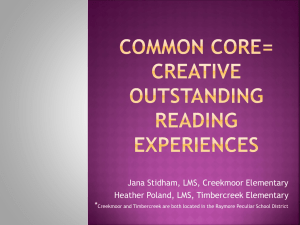
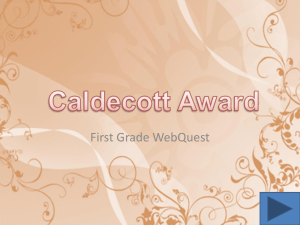
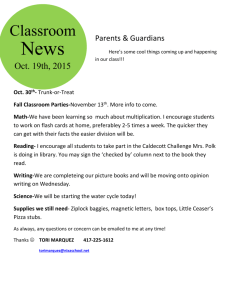
![Creating Worksheets [MS Word, 78 Kb]](http://s3.studylib.net/store/data/006854413_2-7cb1f7a18e46d36d8c2e51b41f5a82fa-300x300.png)
